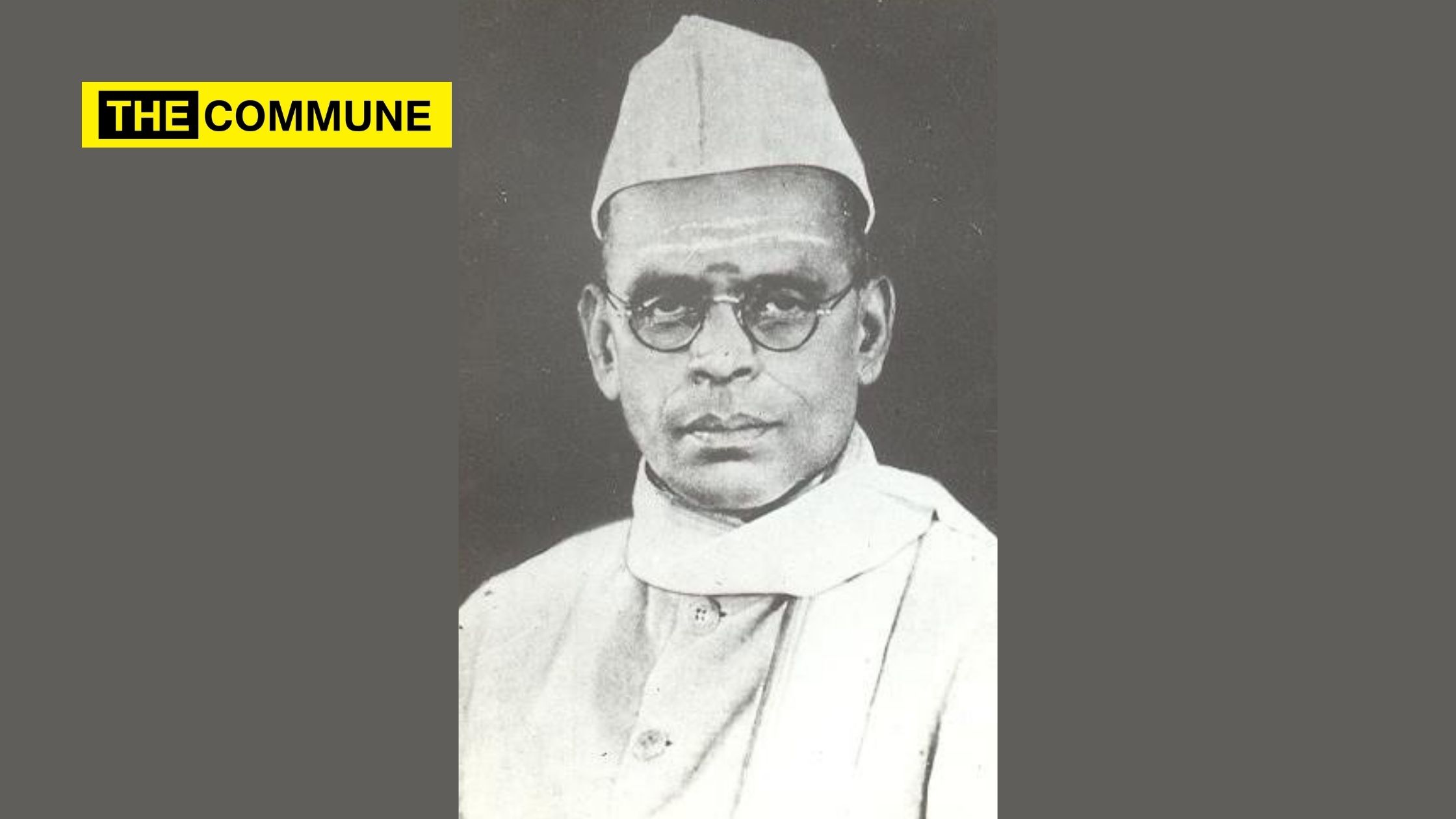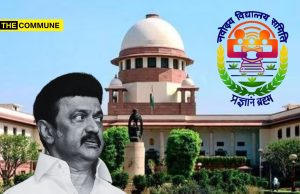
சொலல்வல்லன் சோர்விலன் அஞ்சான் அவனை
இகல்வெல்லல் யார்க்கும் அரிது.
Tirukkural-647.
[Meaning: An articulate, assiduous, assertive person will always be victorious]
A strange phenomenon in Tamil Nadu politics is that, while the lofty services and selfless sacrifices of Kamaraj are recognised with due reverence, the person whom he respectfully regards as his mentor is disdainfully thrown into Lethe of neglect. His name is S Satyamurti. But for a lone building in Chennai, ‘Satyamurti Bhavan’ and a reservoir at Poondi, he does not find any mention at all by the present set of politicians. Of course, looking into the character and calibre of the present day Congressmen, the very name Satyamurti has become absolutely irrelevant and they may, in fact, be doing a service to him by not sullying his name by misusing it!
It therefore becomes imperative now that the history of such nonpareil heroes are documented in detail for posterity to enable them to understand the efforts and endeavours, services and sacrifices of our earlier generation in all dimensions.
Our nation’s freedom movement was pioneered by many stalwarts, each one, an intellectual giant in his own right with a distinctive approach, as a natural consequence of which, each of them had a different strategy to achieve the desired goal. In the process they themselves found fault with each other and fought for justifying their stand. At one extreme, we had fighting fire-brand frondeurs like Bhagat Singh, Rajguru and Vanchinathan and at the other extreme, moderates with mellowed methods like Gokhale, Ranade and C R Das. Satyamurti, although an outstanding orator, fearless fighter and a dynamic, daring debater, with a facile, fluent tongue and a flair for repartees, advocated a cooperative, conciliatory course with the British rulers for getting freedom. Nevertheless, Satyamurti never hesitated to cross swords even with Goliaths like Gandhiji, Rajaji, Annie Besant to establish his point of view. In fact, his outspokenness and daring differences with sections of the Congress leadership seemed to have worked against him. Although, with his powerful campaign speeches, he played a major role in the Congress’ victory in the 1937 polls to the Madras Legislative Assembly, he was left out of the first ever Congress Government formed by Rajaji. While outwardly being polite to him, the top Congress leaders never took kindly to his courage in speaking his mind and forcefully advocating what he considered to be the right course of action.
Early life
Satyamurti was born on August 19th 1887 at Thirumayam in the former princely state of Pudukkottai. His father Sundara Sastriar was a scholar and a pleader by profession. After finishing Intermediate in the Pudukottah Maharaja’s College, Satyamurti joined the Madras Christian College for his B.A. (History). After graduation, he became a tutor in the same college before joining the Madras Law College. Upon successful completion of Law, he joined as an apprentice in the Chambers of Mr. V .V. Sreenivasa Iyengar and later with Shri S. Sreenivasa Iyengar, former President of the Indian National Congress.
Political Career
While he was with Shri S. Sreenivasa Iyengar, Lokmanya Tilak and silver tongue Srinivasa Sastri recognised the qualities of leadership, eloquence, dignity and integrity in him, which is indeed, a fitting tribute coming from two eminent luminaries of those times.
His political career started in 1919 when, at the young age of 32, he was made the secretary of the Congress delegation that went to the Joint Parliamentary Committee in UK to protest the Montagu-Chelmsford reforms and the Rowlatt Act.
Later, he became a leading member of the Swaraj Party along with Motilal Nehru and C R Das. He went to England again in 1926, this time on behalf of the Swaraj Party, to explain to the British public the kind of lives Indian are living and how the British Crown and the British politicians are dodging the question of giving freedom to India. Between 1930-1932, Satyamurti, responding to the clarion call of the Mahatma for non co-operation with British ruler, defied prohibitory orders, courted imprisonment and was sentenced to rigorous imprisonment.
In 1930, he hoisted the Indian flag atop the Parthasarathy Temple at Chennai and was arrested for that act.
He was appointed Mayor of the city of Madras in 1939. When the city faced an acute shortage of water, he urged the British government to build a reservoir for the city. It was across Kotralai River in Tiruvallur district of Tamil Nadu State. With a capacity of 2573 Mcft, it is now an important source of water for Chennai city. It was completed in 1944 and sadly, Satyamurti did not live to see his efforts bear fruition. The reservoir is today named Satyamurti Sagar.
In 1940, he participated in the ‘individual satyagraha’ campaign, defying a prohibitory order and making anti-war speeches that invited a lot of trouble for him. This time his imprisonment lasted eight months and again he was arrested in 1942 upon his arrival from Bombay for having participated in the Congress meeting that adopted ”Quit India’ ‘resolution. He was again detained in Amraoti along with other leaders from the south. He died on 28th March, 1943 in the Madras General Hospital, as a martyr for freedom.
The Man Who Mentored Kamarajar
Satyamurti, during his lifetime, was the mentor of K.Kamaraj. He found in Kamaraj “an efficient, loyal, indefatigable worker and skillful organizer”. The two of them grew fond of each other with each passing day and their bond became stronger and stronger. They complemented each others’ skills. In 1936, when Satyamurti was elected President of the Provincial Congress Committee, he appointed Kamaraj as the General Secretary. Four years later they swapped positions. Both of them strengthened the party base with their relentless effort. Kamaraj’s devotion towards his mentor was such that when India gained independence, he first went to Satyamurti’s house and hoisted the Indian flag there. On his election as Chief Minister of Tamil Nadu, Kamaraj went to Satyamurti’s house and garlanded his photo and paid his respects to the leader’s widow. Additionally, he got the headquarters of the Tamil Nadu Congress Committee named as Satyamurti Bhavan in recognition of his tireless work for the Tamil Nadu Congress and for India’s independence. Also, it was Kamaraj who got the Poondi reservoir named as Satyamurti Sagar.
An Educationist
In the realm of education, Satyamurti played a vital role in the establishment of a private institution promoted by the Rajah of Chettinadu Sir. Annamalai Chettiar named as Annamalai University at Chidambaram. Since mid-twenties, Satyamurti was also an active and eloquent member of the Madras University Senate and Syndicate. He introduced numerous educational reforms.
How Satymurti Leveraged Fine Arts For Election Propaganda
Apart from being an outstanding orator and a dashing debater, Satyamurti excelled in histrionic talents also. In the midst of hectic political activity, he managed to devote ample time for the promotion of Carnatic music and resurgence of classical dance. For some time, he became the Vice-President of Madras Music Vilas Sabha, an amateur theatrical group of great repute that nourished young talents.
Satyamurti was instrumental in the birth of the Music Academy at Madras. As President of the Faculty of Fine Arts, University of Madras, and the Chairman of the Board of Studies in Music, he created a degree course in carnatic music in Annamalai University. Against fierce opposition, he introduced Bharata Natyam in Music Academy.
In earlier years, he had been an accomplished stage actor in classic drama, playing the title role in Manohara, a didactic historical play. Satyamurti was elected President of South Indian Film Chambers in 1937 and 1938, and was invited to preside over the All India Motion Picture Congress at Bombay in 1939.
After the Jallianwala Bagh massacre, press censorship was strict. But, a genius always finds a door when others see only a wall. Being an accomplished actor himself, he roped in stage actors and singers to campaign for the Congress party. “We shall sing our way to freedom.” was his clarion call. While puritans in Congress party resented his move, he went ahead relentlessly. His masterly stroke proved a massive, monumental success. Veterans like TKS Brothers responded with exuberance, energy and enthusiasm. The super singer of those days gifted with a stentorian voice, KB Sundarambal was the star attraction.
A special gramophone record containing the songs of Sundarambal and Musiri Subramania Iyer along with election appeals carried the desired message to the households. As a result Congress emerged with thumping success with 74% seats in the state.
Such was the Congress juggernaut that some opposing candidates opted to withdraw rather than fight the polls. The first unopposed return to the Assembly was announced a month before the election from the Sattur-Aruppukottai rural constituency. The winner’s name was K Kamaraj Nadar!
During the election campaign, shocked that her mentor had ignored his career for the sake of national interests and was living in a rented house, Sundarambal bought him a bungalow in T Nagar which was named by him as “Sundara” as a gesture of gratitude. Coincidentally, the name of his father was also Sundara Sastriar!
As fate would have it, strangely enough, and we can even add unfortunately, this unique technique of involving theatre in politics was copied much later with resounding success by the bete noire of Satyamurti, viz., the then Justice party, rechristened as Dravidian party during their elections.
Last Days
He was tried and deported to Amravathi Jail in Nagpur and was hurt in the spinal cord during the journey. He succumbed to his injuries at General Hospital, Madras on March 28, 1943, four years before India’s Independence. Thus, a hectic life coupled with chronic diabetes soon saw his health breaking down, and his arrest during the Quit India Movement in 1942 effectively finished off a promising life.
The Congress in Tamil Nadu which was once home to such towering leaders fervid towards the nation’s cause is now standing with a begging bowl at the gates of Arivalayam.
Click here to subscribe to The Commune on Telegram and get the best stories of the day delivered to you personally.




